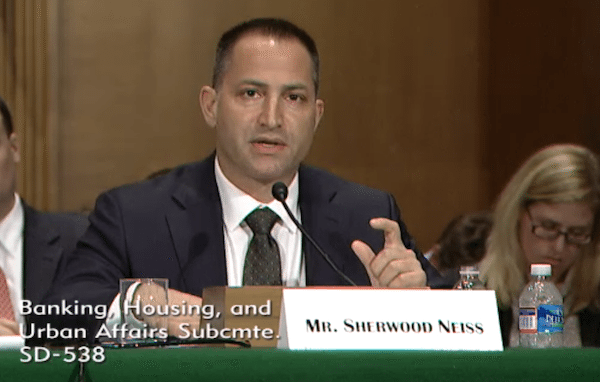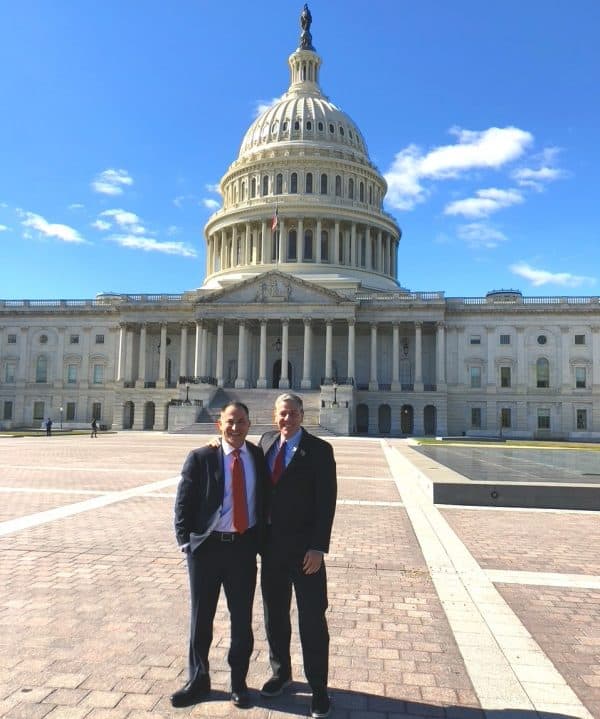The exempt securities marketplace can be arcane and challenging to manage for entrepreneurs seeking to raise capital. The advent of online capital formation has helped to democratize access to capital as well as streamline securities offerings but hurdles do remain. A new startup co-founded by several prominent names in the investment crowdfunding industry seeks to facilitate secondary transactions for private securities.
Sherwood “Woodie” Neiss, co-founder of Crowdfund Capital Advisors, Doug Ellenoff, Managing Partner of Manhattan law firm of Ellenoff, Grossman, and Schole, and Jim Dowd, founder and CEO of North Capital Private Securities, have joined to launch GUARDD: A Fintech designed to support secondary market trading for private company securities, including digital assets/tokens to facilitate compliance with both federal transparency requirements and state blue sky laws.
According to a note from the company, GUARDD enables the necessary disclosure and dissemination of private company information for investors, regulators, and market participants. This allows issuers to comply with federal and state financial disclosure requirements related to the trading of private company securities in secondary markets, thus addressing a challenge regarding exempt securities that tend to be illiquid. Overall, more liquidity can help price discovery while boosting interest in private securities.
Following the announcement that the platform is now live, Crowdfund Insider contacted Neiss with questions regarding the platform’s operations and his expectations for GUARDD. Our discussion is shared below.
You have been in the securities crowdfunding space for a long time so you understand the sector well. How did the concept for GUARDD emerge?
Woodie Neiss: When the final rules came out for Regulation Crowdfunding (Reg CF) we knew that these securities could be available for secondary transfer after the one-year holding period was up. We also knew for Regulation A+ offerings those securities could be transferred immediately. However, nothing in the rules addressed the obstacles issuers would have to face to be in compliance with state laws that govern the secondary transfer of securities nor pre-empted state laws.
At that point, a seed was planted but it didn’t sprout until the industry had a chance to evolve and Online Investment Platforms, as well as Alternative Trading Systems (ATSs), started to express interest in facilitating the secondary transfer of securities.
At this point, we knew that it would be incredibly difficult and costly for issuers to tackle the 50 different state laws that govern the secondary transfer of securities. But we also knew the Manual Exemption could be a pathway. It would require getting issuers to provide ongoing disclosures in a National Securities Manual. Such a pathway for private companies didn’t exist. It was then that we decided to embark on developing a Technology solution to enable this.
Effectively, you are making private securities compliant under Blue Sky rules for secondary transactions. How do you accomplish this?
Woodie Neiss: There are very few exemptions under which issuers do not have to register their offerings or resales under state laws. These include non-solicitation and private isolated offers and sales to accredited investors. The only way one can have broad exemption is to publish ongoing company and financial information in what is known as a National Securities Manual. We spent almost 3 years building the technology and solution and socializing it with NASAA and the state regulators. GUARDD standardizes private company reporting much like a 10k or a 10q does for a public company. We work with issuers that have performed an audit so that a CPA has verified the integrity of information disclosed. We then take their GUARDD report and audit, run it through our blue sky compliance team, and publish it in a National Securities Manual.
You are working with several partner firms to achieve this goal. Who are these firms and what service do they provide?
 Woodie Neiss: GUARDD is a joint venture between Doug Ellenoff of Ellenoff, Grossman, and Schole, James Dowd of North Capital, and myself. I developed the framework for the reporting based on what information investors are used to seeing in public disclosures, Rule 144 reporting, Reg A+ reporting, and the like. Doug and his firm have provided invaluable feedback on Blue Sky laws and how we can navigate them to develop a technology that solves for the Manual Exemption challenge while making sure investors have key information to keep them updated and informed about a company’s wellbeing. Jim and North Capital have provided valuable input into the lens under which broker-dealers vet companies and information that would benefit investors as well.
Woodie Neiss: GUARDD is a joint venture between Doug Ellenoff of Ellenoff, Grossman, and Schole, James Dowd of North Capital, and myself. I developed the framework for the reporting based on what information investors are used to seeing in public disclosures, Rule 144 reporting, Reg A+ reporting, and the like. Doug and his firm have provided invaluable feedback on Blue Sky laws and how we can navigate them to develop a technology that solves for the Manual Exemption challenge while making sure investors have key information to keep them updated and informed about a company’s wellbeing. Jim and North Capital have provided valuable input into the lens under which broker-dealers vet companies and information that would benefit investors as well.
Needless to say, this partnership works best because we each put in our core competencies to tackle a market challenge and leverage our experience to develop the solution.
Which states can (or will) you facilitate?
Woodie Neiss: GUARDD will assist issuers to qualify for the Manual Exemption. The Manual Exemption is recognized in 40 states and jurisdictions. Rather than spending over $40,000 to register in all those states, we can guide issuers through the process in as little as a few days and at a fraction of the cost. In the other 10 states, we provide guidance on how issuers can register/complete file notices such that an issuer’s securities can trade in all 50 states. With GUARDD, issuers should be able to have their securities legally compliant to trade on any ATS.
Do you have agreements in place with ATS’s? How large is this market?
Woodie Neiss: The way in which we work with ATSs is first to make sure they are aware of the Blue Sky challenges and the limited exemptions that exist. Then we show them how GUARDD can create a compliant pathway for issuers such that neither the issuer nor ATS should be breaching any state laws that govern the secondary transfer of securities. We show them how once an issuer has a GUARDD report approved, we provide the ATS hyperlinks to both the National Securities Manual listing as well as the GUARDD report. (The GUARDD report contains more detail that one would find in the Manual listing like beneficial owners and use of proceeds from the most recent two offerings). We ask that ATSs that wish to work with us, make GUARDD be part of their compliance process for issuers that trade on their system.
We believe that there are potentially 100,000 companies that would desire liquidity for their investors, want to use GUARDD for both their ongoing reporting and Blue Sky needs, and have their securities traded on ATSs.
With this missing link, the secondary trading market can finally realize its full potential. This will benefit not just investors who will have real access to company information, but regulators as well who will have clarity as to who is buying and selling securities and issuers who can raise more capital by letting investors know that their investment need not be tied up until an exit but can be sold prior on an ATS if they so desire liquidity.
What about non-accredited investors?
Woodie Neiss: Non-accredited investors might be one of the biggest beneficiaries of GUARDD.
Private company information is very challenging to come by. Even at that, once an investor invests, depending on the exemption relied upon for the initial sale, there’s no set requirement that a company provides ongoing disclosures about their company and financial well being.
GUARDD creates a streamlined process for companies to provide these updates and do so in a way that gives investors key ongoing information so they can make informed decisions about whether or not to buy or sell a private security.
Will the recent changes announced by the SEC boost your mission? Was it challenging working with the various regulators?
Woodie Neiss: I definitely think the recent changes announced by the SEC will boost our mission.
Anyone that has raised capital knows how challenging it is. One of the biggest challenges is the lack of liquidity for investors. By increasing the maximum issuers can raise compounded with the ability of GUARDD to allow for liquidity, we believe more issuers will leverage these federal exemptions to issue primary shares with the knowledge that some of those same shares can be compliantly traded on ATSs in the future (after the expiration of any applicable holding period).
Working with regulators is a part of the job. Unfortunately, their focus is on identifying fraud. So it is challenging for them to see how technologies like this can both benefit investors and make their lives easier. This is why we make GUARDD free to access for regulators because we believe they are a key part of protecting investors, just like we believe ongoing disclosures are.
You are live now, correct?
Woodie Neiss: We just went live this week and have been surprised at the number of ATSs that have contacted us.
They all understand their challenge when it comes to Blue Sky laws and seem to be thrilled that there is a compliant solution.
We look forward to more of these calls and onboarding their clients that need Blue Sky clearance.
And what about digital assets?
Woodie Neiss: GUARDD is a reporting tool for securities that wish to trade on ATSs. This includes traditional securities as well as digital ones.
If a company has issued digital securities in compliance with the securities laws, we capture about a dozen key characteristics about that token in our GUARDD report so that investors can understand the dynamics of that digital asset and be informed about it as well.


